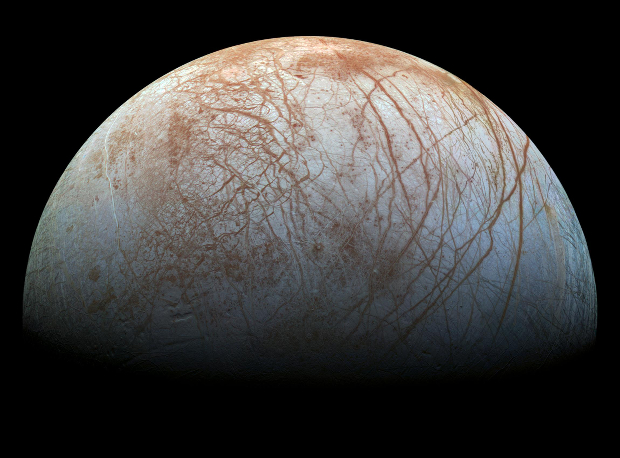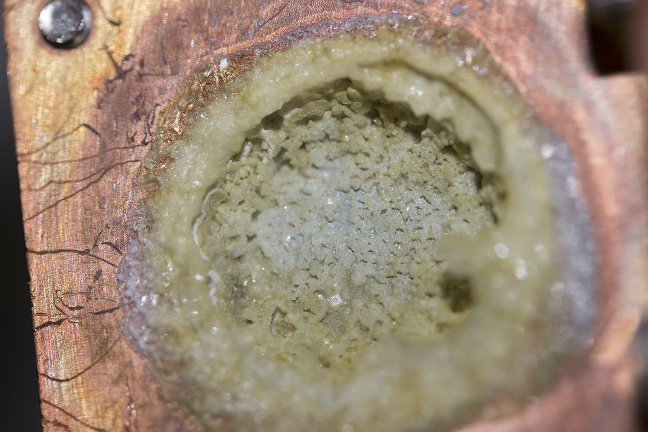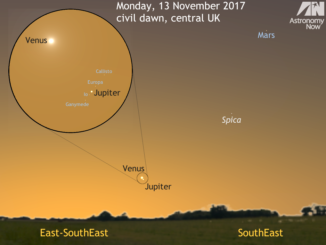
A decade-long question about the nature of dark spots on Europa’s surface has potentially been solved, with scientists suggesting that these spots are likely signs of irradiated sea salt from a subsurface ocean, deposited onto the surface through interactions with its rocky seafloor. If this is indeed the case, then these findings are an important consideration for assessing the habitability of the planet and whether it could support life or not.
In order to determine what the substance on Europa’s surface could be, the research duo, lead by Kevin Hand, a planetary scientist at NASA’s Jet Propulsion Laboratory in Pasadena, California, exposed compounds of sodium chloride – common salt – along with mixtures of salt and water in a special vacuum chamber designed to emulate the surface of Europa. “We call it our ‘Europa in a can,'” said Hand. “The lab setup mimics conditions on Europa’s surface in terms of temperature, pressure and radiation exposure. The spectra of these materials can then be compared to those collected by spacecraft and telescopes.” To correctly replicate Europa’s chilly surface meant setting the laboratory test apparatus to a freezing temperature of minus 173 Celsius (minus 280 degrees Fahrenheit). As Europa is bathed in energetic electrons and ions (atoms with added or missing electrons) emanating from within the jovian magnetosphere, the next step was to bombard the samples with an electron beam in order to simulate the intense irradiation processes occurring on the moon’s surface.
The team found that after a few tens of hours of exposure, which for a ~20 hour experiment is equivalent to nearly a century’s worth of irradiation on Europa’s surface, the salt samples had turned from their initial white appearance to a yellowish-brown hue. This change in colouration when compared with features on the icy moon, showed a strong resemblance to the colour seen by NASA’s Galileo mission of fractures on the surface of Europa. If these fractures are indeed salt deposits, what does this mean for the icy moon’s subsurface oceans? “The key here is that the salts indicate water interacting with rock – in this case its likely Europa’s ocean leaching through a rocky silicate seafloor drawing out ions like Na+ and Cl-” explains Hands.

But not all of the dark material on Europa is the same stuff. Previous studies on the discolouration of Europa’s surface have been attributed to sulphur chemistry. “Much of what we see on the trailing hemisphere – the so-called bullseye region is likely sulphuric acid and radiation processed sulphate salts,” explains Hand, “and some of the brown and yellow material is definitely from eugenic sulphur, i.e. sulphur erupting from volcanoes on Io and then hitting Europa’s surface. That sulphur gets radiation processed into sulphuric acid, sulphur dioxide, and sulphide.”
Proving that chloride salts originate directly from Europa has been hard to establish as the salts are spectrally inactive (meaning that they are not directly observable) over the visible and much of the infrared electromagnetic spectrum – spectral regions that are utilized by many spacecraft and telescopes in remote sensing. By examining salty solutions on Earth, researchers have got round limitations imposed by instruments aboard current spacecraft to find alternative ways in which to explain Europa’s surface coloration.
If these dark spots are indeed briny compounds, then variations in their colour could also provide scientists with clues as to just how fresh these deposits are – spots that are weaker in colour would be indicative of deposits younger than one to ten years, whereas older terrains would show darker, more saturated colours having been exposed to radiation for longer. “If it’s just salt from the ocean below, that would be a simple and elegant solution for what the dark, mysterious material is,” said Hand. However, Hand and his colleague Robert Carlson have not limited themselves to solely studying common saltly compounds. “A whole series of experiments have been conducted by myself and Robert with various salts and we’re working on submitting these manuscripts as soon as possible” enthuses Hand.



